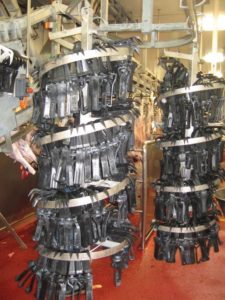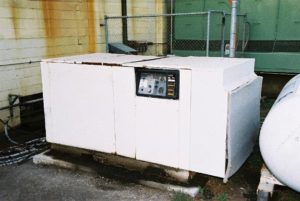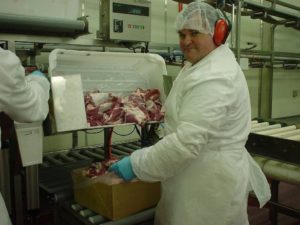Eliminating or reducing noise hazards in the workplace
What is the extent of the noise problem in meat processing plants?
The meat processing industry is a ‘noisy’ industry. As a guide, if you have to raise your voice to communicate with someone about one metre away, the noise is likely to be hazardous to hearing. The industry does have a number of hazards that may result in exposure to noise above acceptable levels. Sources of noise in the meat industry include:
- live animals
- knocking devices
- movement of metal hooks
- power tools
- compressed air
- metal screws for conveying product.
Hazardous noise can destroy the ability to hear clearly and can also make it more difficult to hear sounds necessary for working safely, such as instructions or warning signals. The potential for noise-induced hearing loss occurs in two main ways:
- prolonged exposure, that is, eight hours exposure to noise levels of 80 dB (A) and above
- exposure to a one-off noise, which can cause immediate hearing damage; the upper limit to which a person may be exposed is 140 dB.
Noise-induced hearing loss is an insidious problem, usually developing slowly over many years. Although employees may think that they have become used to noise, this tolerance is due to temporary hearing loss. Repeated exposure to excessive noise over a period of time will eventually lead to permanent hearing loss.
This hearing loss results when tiny hair-like cells in the inner ear are permanently damaged by too much noise for too long. The damaged cells can then no longer send messages to the brain and hearing is lost. The damage often remains unnoticed until it is too late.
Not only does excessive noise result in permanent hearing loss, it can create other problems such as stress leading to tiredness, irritability and headaches. It can cause dizziness, raise blood pressure and increase heart rate. Noise increases the risk of accidents by disguising sounds of approaching danger or warnings, and negatively affective balance, concentration and communication among co-workers.

Substitution of light weight durable plastic hooks reduce noise
Courtesy Fletcher International © MINTRAC
What are the legal requirements to reduce expose to noise in the workplace?
Senior managers have the primary duty under the WHS Act to ensure, so far as is reasonably practicable, that workers and other persons are not exposed to health and safety risks arising from the business. They also have more specific obligations under the WHS Regulations to manage the risks of hearing loss associated with noise at the workplace, including:
- ensuring that the noise a worker is exposed to at the workplace does not exceed the exposure standard for noise
- providing audiometric testing to a worker who is frequently required to use personal hearing protectors to protect the worker from hearing loss.
Workers have a legal responsibility to take reasonable care for their own health and safety and that they do not adversely affect the health and safety of other persons. Workers must comply with any reasonable instruction and cooperate with any reasonable policy or procedure relating to health and safety at the workplace. For example, if personal hearing protectors are provided the worker must use them in accordance with the information, instruction and training provided on their use.
How are the risks of hearing loss controlled in the workplace?
The ‘Managing Noise and Preventing Hearing Loss Code of Practice’ provides guidance on how to manage the risks of hearing loss associated with noise with management following a systematic process that involves:
- identifying sources of noise that may cause or contribute to hearing loss
- assessing the risks associated with these hazards
- implementing risk control measures
- reviewing risk control measures.
Identifying sources of hazardous noise
Source of noise may be identified by conducting workplace inspections and talking with workers. Available information such as workers compensation claims, manufacturers specifications and industry risk information may help identify sources of excessive noise.
Assessing risks
Senior management may then contract a competent person to assess the risks by carrying out a noise assessment to:
- identify which workers are at risk of hearing loss
- determine what noise sources and processes are causing that risk
- identify if and what kind of noise control measures could be implemented
- check the effectiveness of existing control measures.
Implementing risk control measures
The WHS Regulations require duty holders to work through a hierarchy of control to choose the control measure that most effectively eliminates or minimises the risk in the circumstances. The most effective control measure is to eliminate the source of noise completely, for example by ceasing to use a noisy machine, changing the way work is carried out so hazardous noise is not produced or by not introducing the hazard into the workplace.
If it is not reasonably practicable to eliminate the source of noise, you must minimise the risk associated with hearing loss so far as is reasonably practicable. This includes ensuring that the noise does not exceed the exposure standard by choosing one or more of the following measures:
- substitute the hazard with plant or processes that are quieter
- modify plant and processes to reduce the noise using engineering controls
- isolate the source of noise from people by using distance, barriers, enclosures and sound- absorbing surfaces.
If there is a remaining risk, it must be minimised so far as is reasonably practicable by implementing administrative controls, and if a risk still remains, then suitable personal protective equipment must be provided and used. These two types of control measures, when used on their own, tend to be least effective in minimising risks because they rely on human behaviour and supervision.

Machinery noise is reduced by enclosing the machine
courtesy of Meat and Livestock Australia
What is the workers role in reducing or eliminating noise hazards?

Worker packing trim wearing hearing protection
